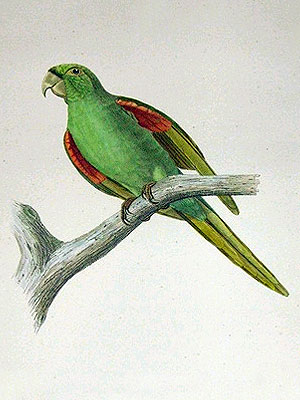Antillean Cave Rail (Nesotrochis debooyi)
The Antillean Cave Rail, which is also known as DeBooy’s Rail, was a large, flightless species that is known exclusively from subfossil remains recovered from cave deposits on the islands of Saint Croix and Saint Thomas in the United States Virgin Islands as well as on Puerto Rico.
The species was originally known exclusively from subfossil midden remains, and it was not clear to which island it originally was native to since the birds appear to have been an important meat-source and to have been transported from island to island by the native inhabitants of the region.:
“There is at beast considerable uncertainty as to the exact place of origin of bone remains from kitchen midden deposits, but it may be supposed that where so many bones representing one species are found, that these came from the island on which the midden was located. There is no proof, however, that they belong to a truly indigenous species, nor is it known that they were not brought as needed from somewhere else. The comparative abundance of the remains of this rail in these deposits when compared with other species of birds indicate that it possessed flesh that was held in high esteem as a source of food. This beeing the case, there is no evidence to show that these rails may not have been kept as captives and transported from island to island by their owners.“
***
The Antillean Cave Rail was later also found in cave deposits on Puerto Rico without any archaeological context and thus appear to have probably been native to that island. [2]
The species might have survived on Puerto Rico into the 19th century: there are stories of a bird called carroo, that was run down with dogs by hunters prior to 1912; the name is now applied to the Limpkin (Aramus guarana (L.)), which is a wary bird with strong flight abilities, that very unlikely can be captured with dogs. [3]
*********************
References:
[1] A. Wetmore: Bones of birds collected by Theodoor de Booy from Kitchen Midden deposits in the islands of St. Thomas and St. Croix. Proceedings of the United States National Museum 54(2245): 513-522. 1918
[2] Alexander Wetmore: Bird remains from the caves of Porto Rico. Bulletin of the American Museum of Natural History 46: 297-333. 1922
[3] Storrs L. Olson: A new species of Nesotrochis from Hispaniola, with notes on other fossil rails from the West Indies (Aves: Rallidae). Proceedings of the Biological Society of Washington 87(38): 439-450. 1974
[4] Jessica A. Oswald; Ryan S. Terrill; Brian J. Stucky; Michelle J. LeFebvre; David W. Steadman; Robert P. Guralnick: Supplementary material from “Ancient DNA from the extinct Haitian cave-rail (Nesotrochis steganinos) suggests a biogeographic connection between the Caribbean and Old World”. Biological Letters 17(3). 2021
*********************
edited: 16.02.2020





